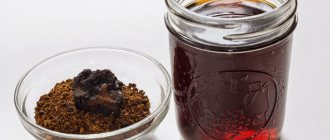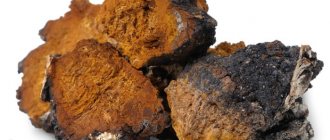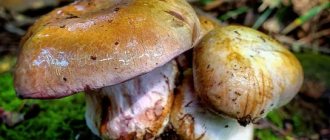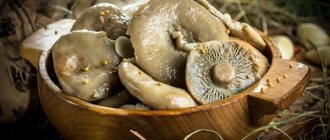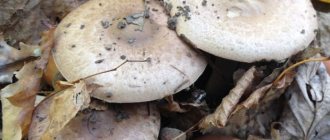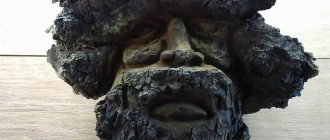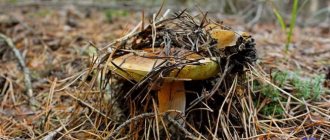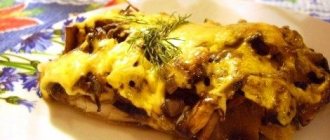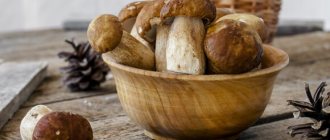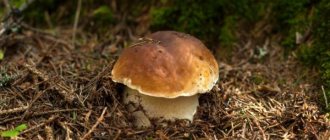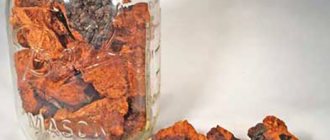Chaga is a birch mushroom in the form of an oval growth on a tree, reaching 40 cm in diameter and weighing up to 5 kg. The outer layer of the mushroom is uneven, with multiple cracks. Inside, the mushroom is hard, brown or yellowish with whitish layers. The distribution environment of chaga is the temperate zone in the Northern Hemisphere, in places where birch grows.
Chaga mushroom appears as a result of infection of tree bark with spores of the parasitic polypore fungus. Spreading through the air, the spores take root only on damaged bark, forming a growth that can develop within 15 years under the right conditions. The growth forms mainly on old trees, since young trees have a powerful resistance to harmful influences.
Healing properties of chaga
Chaga mushroom is a natural antiseptic and antibacterial product that contains immunostimulants. Thanks to its unique composition, the mushroom can increase the defenses of the human body, strengthen the immune system, normalize metabolism, increase performance and relieve fatigue. In addition to these properties, this amazing mushroom has antispasmodic, diuretic and antimicrobial effects on the human body.
The wide spectrum of action allows the use of chaga mushroom to treat the gastrointestinal tract. Chaga infusions help slow the growth of tumors of various origins and improve the general well-being of the patient. The healing effect of chaga in oncology is due to the presence of pterins in its composition - nitrogenous compounds, pigments of the eyes and wings of insects.
Chaga can be used as a medicine and for making drinks.
Even in ancient times, our great-grandmothers used a decoction of it to prepare porridges and jelly and use them for treatment; chaga tea with rose hips, viburnum, and bird cherry was very famous. Recipes for its preparation have been restored from ancient Russian scriptures and are still popular among lovers of natural natural products. To this day, the recipe for old Russian honey sbiten made from chaga with spices is used, which mobilizes strength and concentration well.
Chaga can be used to make drinks
Collection, processing and storage of birch mushroom
Chaga is collected year-round, but the preferred season for harvesting this natural product is late autumn and early spring. To collect, use a knife or an ax to cut the mushroom at the base, separating the less useful yellowish part that is softer in density. A dried mushroom becomes almost stone-like, so it is necessary to cut it into small pieces immediately after collection, then processing will be less difficult.
To store the product for a long time, you need to cut it into pieces and dry it well in the open air or in an oven at a temperature of up to 60°. After drying, the mushroom should have a moisture content of no more than 12% and 1/5 of extractive substances of the total volume. The dried product should be stored in a dry place in a container with a tight lid, protected from moisture.
The preferred season for collecting chaga is late autumn or early spring.
When to collect
The fruiting season for saffron milk caps is from July to September. If the temperature remains optimal, then their first shoot is observed in June.
| Type of mushroom. | Growth period. |
| Real | End of August - beginning of September |
| Spruce | Aug. Sept |
| Red | July-October |
Basic method of preparing chaga
There are various recipes for making chaga at home. Let's look at the basic cooking method. When used, the beneficial substances and healing qualities of the mushroom are better preserved. This method is the most optimal for preparing healing infusions. After all, the preservation of medicinal properties depends entirely on the method of preparing the decoction.
- For proper preparation, you need to wash the prepared pieces of chaga, add boiled water at room temperature and leave for 7 hours until the mushroom is completely softened. Ceramic dishes are more suitable for infusion.
- After 7 hours, the softened mushroom must be removed from the water, squeezed and minced. Next, you need to heat the water in which the mushroom was soaked to 40° and pour it over the rolled chaga in a proportion of 1 part mushroom to 5 parts water. Then the resulting mixture should be infused for 2 days.
- The infused elixir must be filtered and squeezed through cheesecloth, then add water to the original volume. An infusion prepared in this way will preserve the beneficial healing properties of the mushroom components to the maximum extent possible. You need to store it in the refrigerator, covered, and use the decoction within the next 4 days; the mushroom cannot be stored longer. Take the healing infusion half a glass three times a day before meals.
False puffball mushroom: what does it look like, can it be eaten?
comparison of photos of false and edible raincoats with descriptions
The false raincoat should definitely not be eaten - it is fraught with poisoning.
Its distinctive external features:
- shell color pale brown, brown or yellow
- the presence of warts and peeling on the dome
- the pulp has a yellowish or light olive tone
- strong repulsive odor
- the mushroom is completely missing a stem
- the shape is round and starts just above the surface of the ground
A quick way to infuse chaga
In terms of therapeutic effect, this method is somewhat inferior to the main one, but still, preserving the beneficial organic components of the mushroom allows you to achieve good results in treatment with this infusion. The cooking sequence is as follows:
- Wash the chaga and chop it into small pieces;
- infuse the mushroom in 5 parts boiled water for about 7 hours;
- Filter the infusion by squeezing the mass through cheesecloth;
- Consume the filtered infusion within 3 days.
Kinds
The true milkweed is so called because it grows in a pile on a tree and is easy to recognize. It can be dark and white, but has a characteristic strong smell of dampness. When it ripens, then it changes its color: it darkens. His mycelium does not decompose. It grows in the forest along with porcini mushrooms. But this one is a little different from them.
1- Violin (felt weight). 2- Bluish milk mushroom.
Black milk mushroom. His hat is always dark, even black. Another feature is the shape. It is also round, with tubercles. And his legs are long and thin. It grows in large groups rather than one at a time. It is also called nigella. This is the most common mushroom in Russia.
You can often see pepper milk mushrooms. This mushroom is harder than its counterpart. It is very bitter and is rarely harvested because of this.
In addition to pepper, there are other types. For example, bluish and bilious. Not everyone knows how to distinguish pepper mushrooms, because they are very similar. So be careful.
Mushrooms are very important for humans. You can make soup from them, fry them over a fire, make caviar, or prepare a preparation for mushroom sauce. They contain many useful vitamins that are so necessary for our body. But you need to pick mushrooms carefully and know which ones are edible and which ones are not.
1-Oak mushroom 2-Pine saffron milk cap.
Making chaga tea
If you don't have enough time to prepare the decoction, you can make chaga tea. This recipe is suitable for camping conditions, when a freshly harvested product of nature is brewed and drunk like regular tea, but naturally it will be inferior to previous recipes in terms of the number of preserved healing qualities:
- pour crushed chaga into boiling water in a ratio of 1 to 4;
- boil the broth for 15 minutes;
- Cool and take as regular tea.
- To make the tea more healing, pour boiling water over the chopped mushroom, but do not boil it, and leave it for at least one and a half hours. The drink will be even more rich in beneficial properties if you brew the mushroom in a thermos and leave for 12 hours. You can add herbs to the thermos for a brighter aroma and drink this fragrant tea with a spoon of honey.
Puffball mushroom: edible or not, what does it look like?
photo of a giant puffball mushroom against the background of a human hand
This mushroom has many similar representatives, which are classified as inedible species.
Although there is no general consensus among mushroom pickers regarding the edibility of puffball, it can be cooked and served at the dinner table. Place it in your basket when it is young, its flesh is perfectly white.
External distinctive features of the raincoat mushroom:
- the leg smoothly passes into the dome-shaped head-hat
- pulp pure white, elastic
- lack of a classic cap, high thin leg, plates
- the cut is filled with elastic white pulp without cavities or mucus
Traditional medicine recipes from chaga
To effectively use chaga as a healing agent, you should seriously change the quality of your diet, excluding meat, spicy, smoked and salty dishes. During the period of using medicinal decoctions, it is necessary to switch to products of plant origin and dairy products, drink rosehip tea with the addition of honey, and it is also necessary to strictly limit smoking and alcohol intake.
- General restorative baths are very useful; it is preferable to take them in the fall. For this procedure, you need to brew one and a half glasses of chaga in 1 liter of boiling water, leave for 2 hours, add an infusion of medicinal herbs and birch and black currant leaves. Take a bath with the resulting decoction for half an hour several times a week.
- In the treatment of the gastrointestinal tract, chaga is used to regulate stomach acidity and normalize intestinal function. To do this, drink an infusion prepared using the basic method, a quarter glass three times a day, 15 minutes before meals for two weeks.
- For indigestion and constipation, an enema with chaga infusion helps a lot. A decoction is prepared from 50 g of chaga, kept in a glass of water for 6 hours, then the infusion is heated in a water bath for 4 hours. The finished broth is stored in a cold place for 2 days, and before the procedure is heated to body temperature.
- For hypertension, prepare a decoction of one teaspoon of chaga and the same amount of mistletoe herb, soaked in 1 glass of boiling water for 3 hours; at the end of preparation, the mixture is filtered. Drink a quarter glass of tincture before meals three times a day for 3 weeks.
- For tumors of the stomach and intestines, use a tincture of chaga combined with the roots of the serpentine. To prepare the decoction, you need to place 1 part of both products in a thermos, add boiling water and leave for 12 hours. After preparation, filter through cheesecloth and drink a tablespoon three times a day before meals. If the tumor is malignant, then the required daily volume of medicinal infusion is 3 glasses. Take the infusion at any time, dividing it into small portions.
- For the treatment of inflammatory processes in the liver, kidneys, and urinary organs, healing tea is prepared from chaga. To do this, put 3 teaspoons of chaga mixed with 1 teaspoon of black currant leaves in a thermos, pour 500 ml of boiling water, leave for half an hour, then filter and drink like regular tea.
- For psoriasis, it is recommended to use lotions with chaga decoction. Half a glass of crushed mushroom is poured into a thermos, poured 500 ml of boiling water and left for about 6 hours, then filtered and applied as a lotion to the infected areas. The procedure is carried out twice a day for 2 weeks. Also, patients with psoriasis benefit greatly from baths with a healing infusion; they must be taken until they feel better.
- Pulmonary tuberculosis is treated by taking a decoction of chaga three times a day, 3 tablespoons, combining it with the addition of 2 tablespoons of preheated badger fat. Treatment lasts 3 months, then a break of 14 days, and the treatment course is repeated. At the same time, you should diversify your diet with vegetables and fruits, cereals and dairy products. For greater effect, establish a strict diet at a certain time.
- The following recipe is suitable for treating cough: prepare a chaga infusion in a quick way; then chop the onion, half a head of garlic and 30 grams of turnip. Mix these ingredients with a melted stick of butter. Drink 3 tablespoons of infusion, combining with 1 tablespoon of oil mass, three times a day 15 minutes before meals.
- For gynecological diseases (cervical erosion, fibroids, cysts), you can use either taking a medicinal infusion orally or placing tampons soaked in the infusion into the vagina. Tampons are placed at night every other day for 2 months.
- Skin diseases are treated with chaga infusion mixed with a decoction of plantain leaves. Moisten gauze with the prepared mixture and apply it to the affected areas of the skin for 30 minutes. You can simply moisturize the diseased areas of the skin with a medicinal infusion, leaving them moist.
- When treating cardiovascular diseases, a healing infusion of chaga is taken 1 tablespoon three times a day half an hour before meals for 3 months, then take a break for 15 days and the treatment course should be repeated.
https://youtu.be/ktK99xTF90M
Botanical characteristics, where it grows
The chaga mushroom belongs to the Basidiomycetes department; fungal spores are produced and found in special formations - basidia. In folk medicine, chaga usually refers to the sterile form of the fungus, sclerotia. It is formed by Inonotus oblique, which parasitizes in the thickness of the tree.
Fungal spores fall into the cracks of the injured bark of birch, less often alder, rowan, and maple. More often it affects older individuals because their immunity is weakened. The most common species most susceptible to infection are silver birch and downy birch. Chaga hyphae destroy healthy tree cells, cause their necrosis, and core rot of the trunk develops. The pathological process is slow and can take up to 20 years. At the same time, the core of the host plant becomes soft, and light stripes of yellow and brown shades appear on the cut.
After a few years, the mycelium of the fungus forms in the form of a large formation. This usually happens in 3-4 years; a shapeless black growth appears on the trunk, covered with numerous cracks. The shape depends on the nature of the wound through which the fungus penetrated into the trunk. It increases in size, growing up to 40 cm in width and up to 15 cm in thickness. The weight of some specimens can reach 5 kg. When cut, the mycelium has brown pulp, which consists of branched chaga threads. It is very hard, closer to the bark it is softer and lighter, and has yellow veins. Hyphae penetrate the trunk both across and lengthwise (up to 1 m along the entire length). Infection with a parasite always leads to the death of the plant.
By the end of the cycle, the host plant is almost non-viable. At this moment, chaga forms spore-bearing outgrowths in the form of tubes; they tear the integumentary tissue of the tree and protrude around the growth, as well as on the opposite side of the trunk, encircling it. Basidial spores are formed inside, which, after exposing the brown spore-bearing layer, the hymenophore, are sprayed onto other trees. The grown tubes are at first leathery-soft and light, then harden and become red-brown.
Chaga is widespread in mixed forests, where birch grows in close proximity to other tree species. The risk of a tree becoming infected with a fungus increases with close coexistence of plants, because disputes spread faster this way. Most often, the chaga mushroom is found in mixed deciduous forests with moderate humidity; very rarely it can be found in spruce forests with an admixture of birches. The chaga mushroom grows throughout the forests of central Europe and Asia, as well as in Siberia, but does not extend beyond the boundaries of the birch habitat.
Contraindications for the use of medicinal chaga infusions
Chaga is a very potent natural remedy and you should consult your physician regarding its use. You cannot combine the use of infusions from this mushroom with taking penicillin drugs and administering glucose intravenously.
Contraindications for treatment with chaga are chronic colitis and dysentery; pregnant and lactating women should not use such infusions; this mushroom should be used with caution for allergic disorders.
Chaga decoctions are very effective in treating various diseases, and the patient’s well-being improves after just a few procedures. Healing infusions from this natural product will be a wonderful help in the treatment of any disease and a magic elixir to restore your health!
Use of tinder
Some varieties of this class are also used in folk medicine. For example, tinder fungus is used to treat the liver and diseases of the gastrointestinal tract.
Other diseases curable with tinder fungi:
- blood incoagulability;
- diseases of the genitourinary system;
- gout;
- insomnia;
- obesity.
Unlike Inonotus oblique, this basidiomycete is also used in everyday life. The dried fruiting body of the saprophyte is useful for lighting stoves and fireplaces. If you set fire to a dry piece of pulp and leave it to smolder, you can get rid of annoying insects in the room for a long time.
